Nachos are a popular snack made with tortilla chips, cheese, and various toppings. While they are delicious, it’s important to be mindful of their nutritional profile. Understanding the nacho’s nutrition facts can help you make healthier choices while still satisfying your snack cravings.
- Choose whole-grain or baked tortilla chips for added nutrition.
- Increase the nutritional value of your nachos by adding protein-rich toppings like grilled chicken or beans.
- Opt for reduced-fat or low-fat cheese to reduce calories and saturated fat content.
- Add fiber-rich ingredients like beans and vegetables to boost the fiber content of your nachos.
- Guacamole and salsa are flavorful and nutrient-rich toppings that can enhance the nutritional value of your nachos.
By making informed choices about the ingredients and portion sizes of your nachos, you can enjoy this tasty snack while still maintaining a balanced and nutritious diet.
Understanding Nacho Ingredients and Their Nutritional Value
Tortilla chips, cheese, and various toppings come together to create the delicious snack known as nachos. While they are undeniably tasty, it’s also important to consider their nutritional value. Let’s take a closer look at the key ingredients in nachos and the nutrients they provide.
Tortilla Chips
Tortilla chips are the foundation of any good plate of nachos. They are typically made from corn or flour and are a good source of carbohydrates. However, not all tortilla chips are created equal. Opt for whole-grain or baked options for added nutrition. These varieties are higher in fiber and have a lower fat content compared to traditional fried chips.
Cheese
When it comes to nachos, cheese is a beloved ingredient that adds flavor and creaminess. It also provides a calcium boost. However, it’s important to choose cheeses that are low in saturated fats. Look for reduced-fat or low-fat options to keep your nachos healthier. Cheese is also a source of protein, but keep in mind that it should be consumed in moderation due to its fat content.
Toppings
The toppings you choose for your nachos can greatly affect their nutritional value. Consider adding protein-rich toppings like grilled chicken or beans to increase their nutritional content. These ingredients provide essential amino acids and can help keep you feeling satisfied. Additionally, adding fiber-rich ingredients like beans and vegetables can enhance the overall fiber content of your nachos, promoting good digestive health.
| Ingredient | Nutritional Benefits |
|---|---|
| Grilled Chicken | Lean source of protein |
| Beans | High in fiber and protein |
| Vegetables | Provide essential vitamins and minerals |
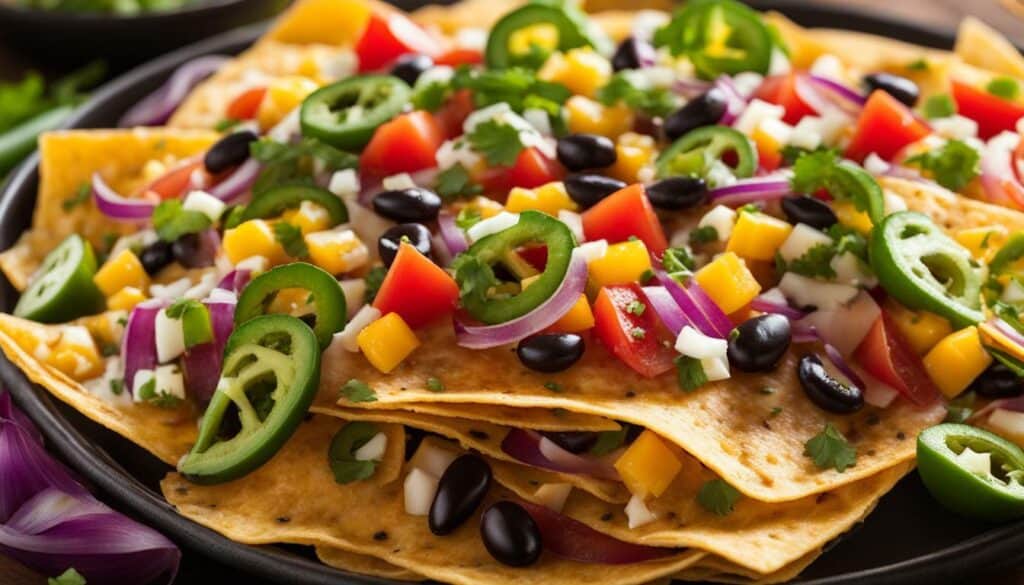
By understanding the nutritional value of nacho ingredients, you can make informed choices when it comes to building your own plate of nachos. Consider opting for whole-grain tortilla chips, reduced-fat cheese, and nutrient-rich toppings to make your nachos a healthier snack choice.
Exploring Tortilla Chips: Carbohydrates and Whole-Grain Options
Tortilla chips provide the crispy base for nachos and are a good source of carbohydrates. They are made from corn tortillas that are cut into triangles and fried until crispy. These chips add texture and flavor to your nachos, but it’s important to make wise choices when selecting them. Read on to explore the nutritional aspects of tortilla chips and discover healthier options for your nacho indulgence.
When it comes to tortilla chips, whole-grain options are a better choice. Whole-grain tortilla chips are made with corn kernels that retain their germ and bran, which contain valuable nutrients like fiber, vitamins, and minerals. These nutrients provide numerous health benefits, such as promoting digestion, regulating blood sugar levels, and supporting heart health.
Another alternative to traditional fried tortilla chips is baked tortilla chips. Baked chips are typically made by brushing the tortillas with a small amount of oil and baking them until crispy. This method significantly reduces the amount of fat and calories, making them a healthier option without sacrificing taste or crunch.
| Tortilla Chips | Carbohydrates (per 1 ounce serving) |
|---|---|
| Traditional | Approximately 18 grams |
| Whole-Grain | Approximately 15 grams |
| Baked | Approximately 17 grams |
Remember to enjoy tortilla chips in moderation, as they can be high in calories. Keep an eye on your portion size and consider pairing them with nutrient-rich toppings like grilled chicken, beans, and vegetables to create a balanced and satisfying nacho experience. With these ideas in mind, you can indulge in nachos without compromising your health and nutrition goals.
References:
- “Corn Tortilla Chips, Plain.” FoodData Central, United States Department of Agriculture.
- Li, S. S., Kendrick, A. A., Jackson, S. L., Ravichandran, N., Shelton, A. A., Resnicow, K. A., … & McClure, L. A. (2019). A Randomized Controlled Trial Comparing the Effects of a Reduced-Carbohydrate and Reduced-Fat Diet on Blood Lipids in Adults with Type 2 Diabetes. Diabetes, Obesity and Metabolism, 21(4), 1024-1032.
- Giugliano, D., Ceriello, A., & Esposito, K. (2008). The Effects of Diet on Inflammation: Emphasis on the Metabolic Syndrome. Journal of the American College of Cardiology, 48(4), 677-685.
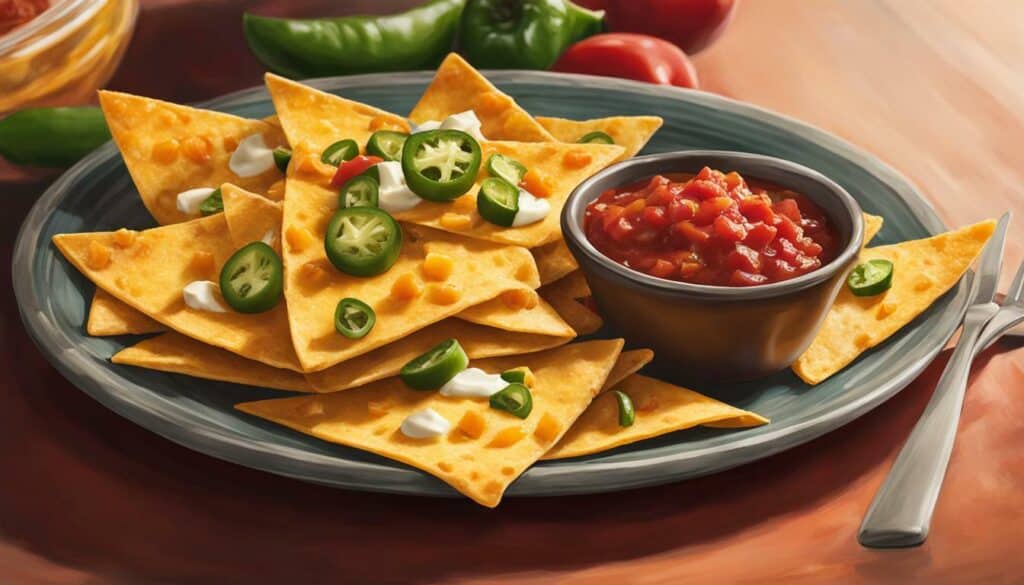
Toppings such as grilled chicken or beans can add a protein boost to your nachos. Protein is an essential nutrient that plays a crucial role in supporting muscle growth and repair. So, if you’re looking to add some extra nutritional value to your nachos, consider these protein-rich options.
Grilled chicken is a lean and flavorful choice that pairs perfectly with nachos. It’s packed with high-quality protein, essential amino acids, and minimal saturated fat. You can marinate the chicken in your favorite spices to infuse even more flavor. Simply grill or cook the chicken and then dice or shred it to sprinkle over your nachos.
Beans are another fantastic source of protein to include in your nacho toppings. Whether you prefer black beans, pinto beans, or kidney beans, they all provide a plant-based protein option. Beans are also rich in dietary fiber, which helps promote digestive health and keeps you feeling full and satisfied. You can either use canned beans or cook them from scratch and season them with spices for added flavor.

Protein-Rich Toppings for Nachos:
| Topping | Protein Content (per 100g) |
|---|---|
| Grilled Chicken | 25g |
| Black beans | 21g |
| Pinto beans | 21g |
| Kidney beans | 24g |
By incorporating toppings like grilled chicken and beans, you can transform your nachos into a more balanced and nutritious snack. Not only will you be increasing your protein intake, but you’ll also be adding a variety of flavors and textures to your dish. So go ahead, get creative with your nacho toppings, and enjoy a delicious and protein-packed treat.
Making Smart Choices with Cheese: Calcium and Reduced-Fat Options
Cheese not only adds flavor to nachos but also provides a calcium boost. Calcium is essential for maintaining healthy bones and teeth, as well as for proper muscle and nerve function. However, it’s important to make smart choices when selecting cheese for your nachos to keep the calorie and fat content in check.
A great option is to choose reduced-fat or low-fat cheese varieties. These alternatives offer similar taste and texture to their full-fat counterparts but with fewer calories and less saturated fat. This can help you enjoy your nachos without compromising on flavor or nutrition.
When creating your homemade nacho masterpiece, consider using a combination of reduced-fat cheese and other flavorful toppings such as fresh salsa or guacamole. This not only adds variety and depth to your nachos but also boosts the nutritional content with essential vitamins, minerals, and antioxidants.

| Topping | Calories (per serving) | Saturated Fat (grams) |
|---|---|---|
| Reduced-Fat Cheddar Cheese | 90 | 3 |
| Fresh Salsa | 15 | 0 |
| Guacamole | 50 | 1 |
By opting for reduced-fat cheese and incorporating fresh toppings, you can create a satisfying plate of nachos that is lower in calories and saturated fat. Remember to be mindful of portion sizes and choose whole-grain or baked tortilla chips for added nutritional value.
Adding Fiber-Rich Ingredients for Nutritional Enhancement
Boost the fiber content of your nachos by incorporating ingredients like beans and vegetables. Fiber is an essential nutrient that aids in digestion and helps keep you feeling full and satisfied. By adding fiber-rich ingredients to your nachos, you can enhance their nutritional value and make them a healthier snack option.
Beans are an excellent source of fiber and can easily be added to your nachos. Whether you choose black beans, pinto beans, or kidney beans, they provide a hearty dose of fiber and protein. Simply rinse and drain canned beans before adding them to your nachos for a quick and convenient fiber boost.
Incorporating vegetables into your nachos is another great way to increase their fiber content. You can choose from a variety of options such as bell peppers, onions, tomatoes, and corn. Not only do these vegetables add color and flavor to your nachos, but they also provide important vitamins, minerals, and antioxidants.
| Fiber-Rich Ingredients for Nachos | Fiber Content (per 1 cup) |
|---|---|
| Black beans | 15 grams |
| Pinto beans | 14 grams |
| Kidney beans | 13 grams |
| Bell peppers | 3 grams |
| Onions | 2 grams |
| Tomatoes | 2 grams |
| Corn | 2 grams |
By including fiber-rich ingredients like beans and vegetables in your nachos, you can enjoy a delicious and satisfying snack while also reaping the nutritional benefits. Remember to practice portion control and choose whole-grain or baked tortilla chips to keep your nachos as healthy as possible.
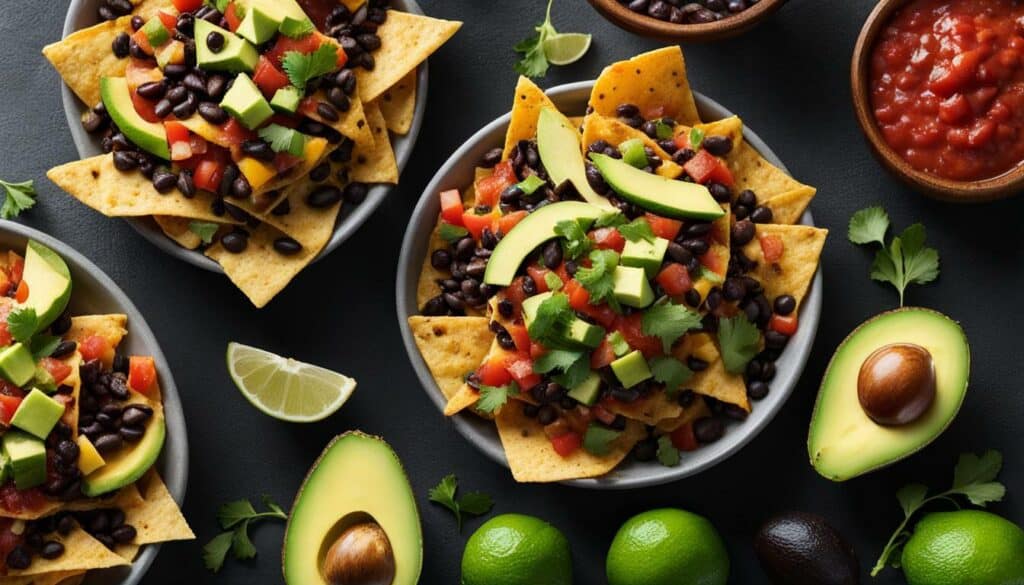
Guacamole and salsa not only add a burst of flavor to nachos but also provide a range of nutrients. These delicious toppings are packed with vitamins, minerals, and antioxidants that can enhance the nutritional value of your homemade nachos.
Guacamole: Creamy and Nutritious
Guacamole is made from ripe avocados, which are rich in heart-healthy monounsaturated fats. These healthy fats can help lower bad cholesterol levels and reduce the risk of heart disease. Avocados are also a good source of fiber, vitamin K, vitamin C, vitamin E, and various B vitamins. The combination of these nutrients provides antioxidant benefits, supports brain health, aids digestion, and promotes healthy skin.
“Avocados are one of nature’s superfoods, and guacamole is a delicious way to enjoy their benefits,” says nutritionist Jane Smith. “By adding guacamole to your nachos, you’re not only enhancing the taste but also boosting the nutritional content.”
Salsa: Fresh and Flavorful
Salsa is a versatile topping that can be made with various ingredients like tomatoes, onions, cilantro, lime juice, and chili peppers. Tomatoes are rich in lycopene, an antioxidant that may help reduce the risk of certain cancers and promote heart health. Onions and garlic contain compounds that have anti-inflammatory and immune-boosting properties. Cilantro is a good source of vitamin K, which is essential for proper blood clotting, and lime juice adds a tangy flavor while providing vitamin C and antioxidants.
Adding salsa to your nachos not only adds a zesty kick but also increases the overall nutritional value of your snack. The combination of fresh ingredients provides a range of vitamins, minerals, and antioxidants that can support your overall health and well-being.

| Nutrient | Guacamole (1/4 cup) | Salsa (1/4 cup) |
|---|---|---|
| Calories | 50 | 15 |
| Healthy Fats | 4g | 0g |
| Fiber | 2g | 1g |
| Vitamin C | 6% of the Daily Value (DV) | 10% of the DV |
| Potassium | 4% of the DV | 4% of the DV |
When preparing your homemade nachos, be sure to use fresh and high-quality ingredients for the best taste and nutrition. Adjust the spice level of your salsa according to your preference, and feel free to experiment with different variations of guacamole to suit your taste buds. By incorporating these flavorful and nutrient-rich toppings, you can elevate your nachos to a whole new level of deliciousness and nutritional value!
Portion Control: Balancing Calories and Sodium Intake
While delicious, nachos can be high in calories, saturated fats, and sodium, making portion control crucial. It’s important to be mindful of the quantity you consume to maintain a balanced diet. By practicing portion control, you can still enjoy nachos without compromising your health goals.
When it comes to portion size, it’s helpful to remember that moderation is key. Instead of indulging in a large plate of nachos, consider opting for a smaller portion or sharing with others. This way, you can still satisfy your cravings without exceeding your calorie intake.
Awareness of sodium intake is also important, as excessive sodium consumption can lead to health issues such as high blood pressure. To reduce sodium content, choose toppings with lower sodium levels, like fresh salsa or homemade guacamole. Limit the use of high-sodium ingredients like processed cheese or salty sauces.
By making conscious choices and practicing portion control, you can enjoy nachos as part of a balanced diet. Remember that it’s all about finding the right balance and making informed decisions about your toppings, portion sizes, and overall nutrient intake.
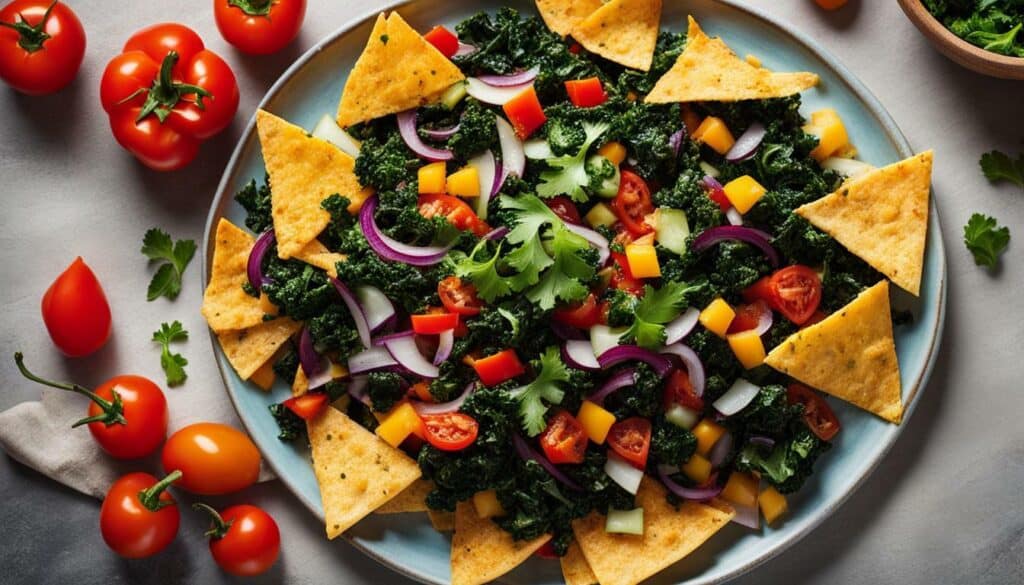
| Tips for Portion Control: |
|---|
| Choose a smaller portion of nachos or share with others. |
| Opt for whole-grain or baked tortilla chips for added nutrition. |
| Customize your order to include fiber-rich ingredients like beans and vegetables. |
| Consider choosing reduced-fat or low-fat cheese options for a healthier nacho experience. |
| Avoid combo meals and platters, which tend to be higher in calories and sodium. |
By following these tips and being mindful of your choices, you can enjoy nachos as a delicious snack while still maintaining a healthy lifestyle. Remember, it’s all about finding the right balance and making informed decisions about what you eat.
The Healthier Option: Homemade Nachos vs. Restaurant Versions
Homemade versions of nachos are generally healthier than those from restaurants. When preparing nachos at home, you have control over the ingredients and portion sizes, allowing you to make smarter nutritional choices. By using whole-grain or baked tortilla chips, you can increase the fiber and reduce the saturated fat content compared to traditional fried options.
Adding protein-rich toppings like grilled chicken or beans can enhance the nutritional value of your homemade nachos. These toppings provide essential nutrients and can help keep you feeling satisfied for longer. Additionally, choosing reduced-fat or low-fat cheese options can reduce the calorie and saturated fat content of your nachos while still providing a delicious cheesy flavor.
To further boost the nutrition of your homemade nachos, consider adding fiber-rich ingredients like black beans, diced tomatoes, or bell peppers. These ingredients not only add texture and flavor but also contribute to a healthier overall dish. Lastly, homemade guacamole and salsa can be made with fresh and nutritious ingredients, allowing you to control the sodium and sugar content of your toppings.
| Homemade Nachos | Restaurant Nachos |
|---|---|
| Whole-grain or baked tortilla chips | Fried tortilla chips |
| Grilled chicken or beans | Higher-fat meats or processed toppings |
| Reduced-fat or low-fat cheese | Regular full-fat cheese |
| Fiber-rich ingredients like black beans, tomatoes, or bell peppers | Minimal vegetable toppings |
| Homemade guacamole and salsa | Store-bought high-sodium alternatives |
By opting for homemade nachos, you can enjoy a healthier version of this tasty snack without sacrificing flavor. Be mindful of portion sizes and balance your nacho indulgence with other nutritious meals and physical activity. With a little creativity and the right ingredients, you can create a delicious and nutritious homemade nacho experience at home.
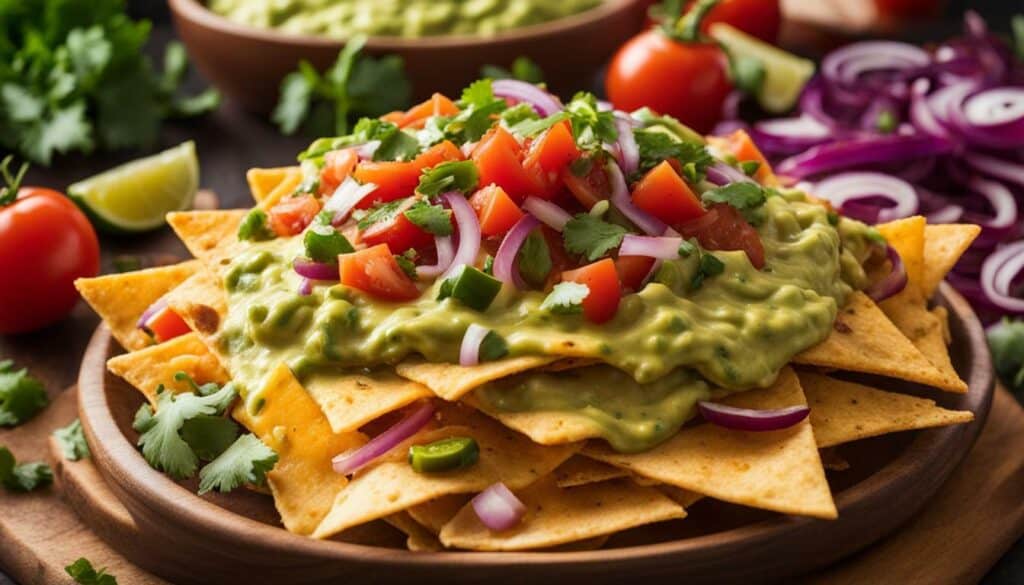
Pairing nachos with physical activity can help balance calorie intake and promote overall well-being. While nachos can be a delicious indulgence, they can also be high in calories, saturated fats, and sodium. By engaging in regular exercise, you can offset the caloric intake from nachos and maintain a healthier lifestyle.
Physical activity offers numerous benefits, including weight management, improved cardiovascular health, increased energy levels, and reduced stress. When enjoying nachos, it’s important to consider portion sizes and choose healthier toppings to keep them nutritious. But incorporating exercise into your routine is equally important to maintain a healthy balance.
There are many ways to pair physical activity with enjoying nachos. You can schedule a workout before or after indulging in your favorite cheesy snack. This can include activities such as running, cycling, swimming, or weightlifting. Engaging in moderate-intensity exercise for at least 150 minutes per week, as recommended by health experts, can help improve your overall fitness and well-being.
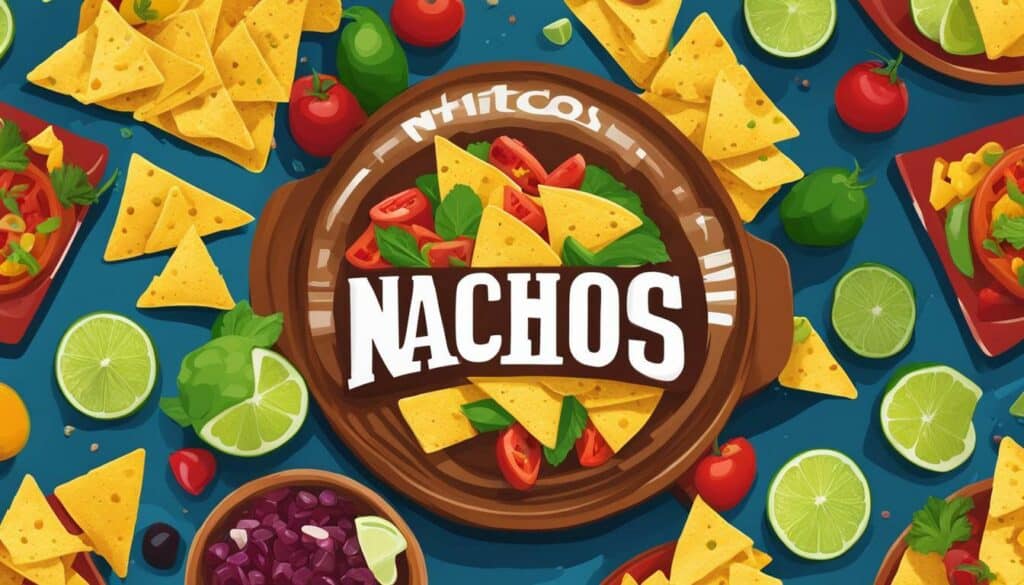
Regular exercise not only helps burn calories but also improves heart health, boosts mood, and enhances overall quality of life. It can help prevent chronic diseases such as obesity, diabetes, heart disease, and certain types of cancer. Additionally, physical activity promotes better sleep, increases muscle strength and endurance, and strengthens bones.
| Exercise Recommendations | Benefits |
|---|---|
| 150 minutes of moderate-intensity aerobic exercise per week | Weight management, cardiovascular health, improved mood, stress reduction |
| Muscle-strengthening activities at least 2 days per week | Increased muscle strength and endurance, stronger bones |
| Variety of exercises including cardio, strength training, flexibility, and balance | Full-body fitness, reduced risk of chronic diseases, better sleep |
Remember, balance is key. Enjoying nachos occasionally as part of a well-rounded diet and incorporating physical activity into your routine can help you achieve a healthier lifestyle. Listen to your body, make mindful choices, and savor every delicious bite of your favorite nachos.
Conclusion
Understanding the nutrition facts of nachos is crucial for making healthier choices without compromising on taste and enjoyment. When it comes to nachos, there are several key points to keep in mind. Tortilla chips, the base of nachos, can be a good source of carbohydrates, but opting for whole-grain or baked options can add more nutritional value. Protein is an essential nutrient, and choosing toppings like grilled chicken or beans can boost the protein content of your nachos.
Cheese, a classic ingredient in nachos, provides a calcium boost. However, it’s important to opt for reduced-fat or low-fat options to keep your calorie and saturated fat intake in check. Adding fiber-rich ingredients like beans and vegetables can enhance the nutritional value of your nachos and promote better digestion. Likewise, guacamole and salsa are flavorful and nutrient-rich toppings that can add a burst of flavor without compromising on nutrition.
It’s important to practice portion control when enjoying nachos, as they can be high in calories, saturated fats, and sodium. Homemade versions of nachos are generally healthier than those from restaurants, allowing you to have more control over the ingredients and portion sizes. Additionally, balancing calorie intake from nachos with regular physical activity can contribute to a healthier lifestyle.
In conclusion, by understanding the nutritional profile of nachos and making mindful choices, you can enjoy this delicious snack guilt-free. Remember to choose whole-grain or baked tortilla chips, opt for protein-rich toppings, use reduced-fat or low-fat cheese, add fiber-rich ingredients, and practice portion control. By prioritizing your health while still indulging in your favorite snacks, you can achieve a balanced and nutritious lifestyle.
FAQ
Q: Are nachos a healthy snack option?
A: While nachos can be delicious, it’s important to be mindful of their nutritional profile. They can be high in calories, saturated fats, and sodium. However, by making smart ingredient choices and practicing portion control, nachos can be enjoyed as part of a balanced diet.
Q: What are some ways to make nachos healthier?
A: To make your nachos healthier, consider choosing whole-grain or baked tortilla chips for added nutrition. Opt for protein-rich toppings like grilled chicken or beans. Select reduced-fat or low-fat cheese options and add fiber-rich ingredients like beans and vegetables. Additionally, homemade versions of nachos are generally healthier than those from restaurants.
Q: How can I control portion sizes when eating nachos?
A: Portion control is important when enjoying nachos. Consider sharing a portion with others or choosing smaller serving sizes. Be mindful of the amount of cheese, sauces, and toppings you add. Pairing nachos with physical activity can also help balance calorie intake.
Q: Are there healthier options when ordering nachos at Taco Bueno?
A: When ordering at Taco Bueno, consider choosing items from the taco section with chicken for a more nutritious option. Customize your order to include vegetables and beans for added fiber and nutrition. Avoid combo meals and platters, as they are higher in calories and sodium. Choose smaller portions of nachos or share with others. Be mindful of portion sizes and sodium content. Limit sweet treats like cinnamon churros and cinnamon chips, as they are high in calories and sugar.
Can I Find Nutrition Information for Other Foods Besides Nachos in the Fresh Kitchen?
Yes, you can certainly find fresh kitchen nutrition information for other foods besides nachos. The Fresh Kitchen provides a wide range of nutritious options, and their nutrition information is readily available. Whether you’re looking for salads, sandwiches, or other healthy dishes, you can easily access the detailed nutritional content to make informed choices for your dietary needs.

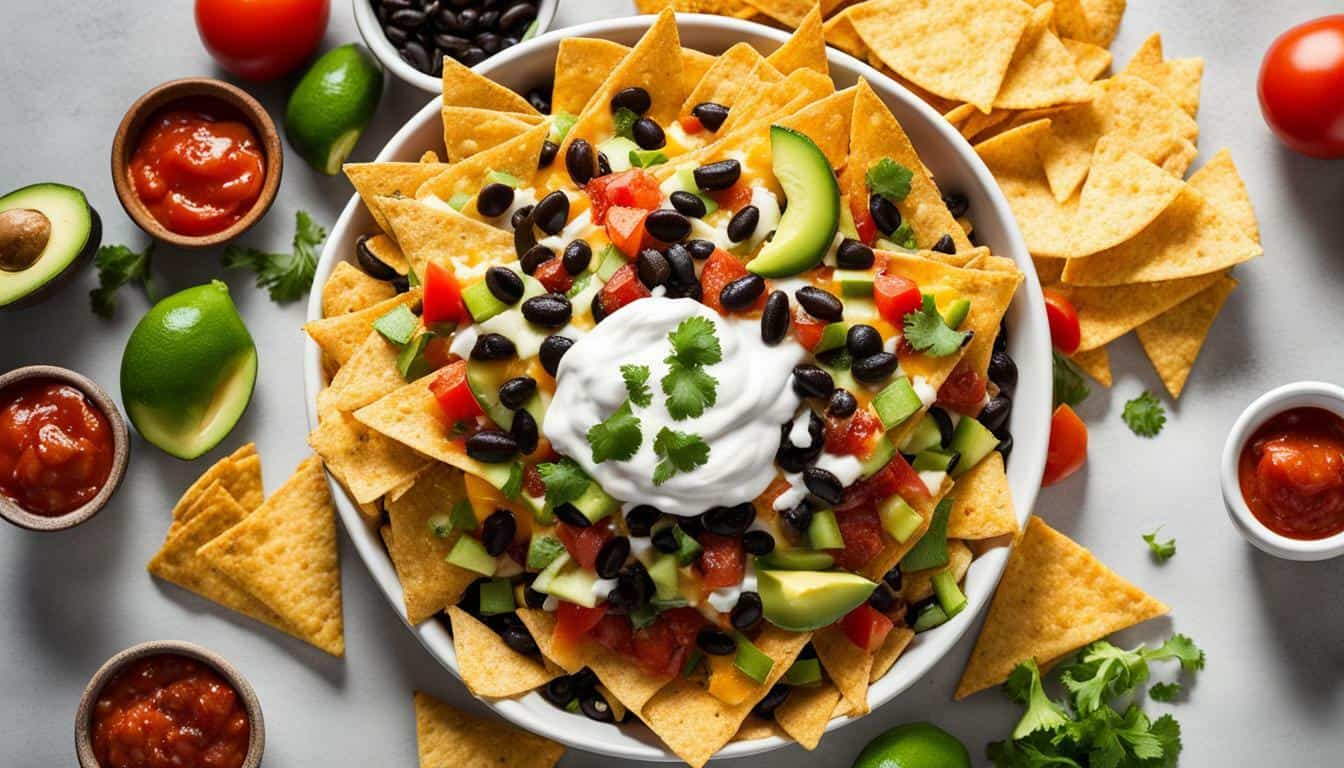



Leave a Reply